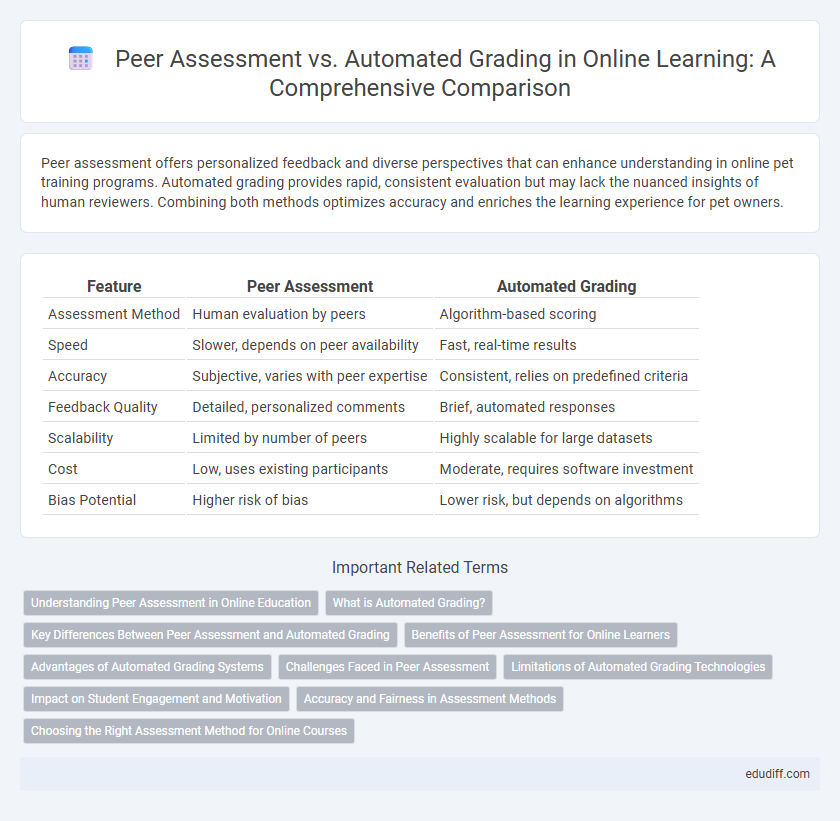Peer assessment offers personalized feedback and diverse perspectives that can enhance understanding in online pet training programs. Automated grading provides rapid, consistent evaluation but may lack the nuanced insights of human reviewers. Combining both methods optimizes accuracy and enriches the learning experience for pet owners.
Table of Comparison
| Feature | Peer Assessment | Automated Grading |
|---|---|---|
| Assessment Method | Human evaluation by peers | Algorithm-based scoring |
| Speed | Slower, depends on peer availability | Fast, real-time results |
| Accuracy | Subjective, varies with peer expertise | Consistent, relies on predefined criteria |
| Feedback Quality | Detailed, personalized comments | Brief, automated responses |
| Scalability | Limited by number of peers | Highly scalable for large datasets |
| Cost | Low, uses existing participants | Moderate, requires software investment |
| Bias Potential | Higher risk of bias | Lower risk, but depends on algorithms |
Understanding Peer Assessment in Online Education
Peer assessment in online education fosters critical thinking and deepens learners' understanding by engaging students in evaluating each other's work, promoting active participation and collaborative learning. Unlike automated grading, which relies on algorithms and predefined criteria for consistent and rapid evaluation, peer assessment incorporates diverse perspectives and nuanced feedback that can address subjective elements of assignments. This method enhances metacognitive skills and accountability, making it a valuable complement to automated systems in digital learning environments.
What is Automated Grading?
Automated grading is a technology-driven process that uses algorithms and artificial intelligence to evaluate student work, providing instant and objective feedback. It analyzes various formats, such as essays, multiple-choice tests, and coding assignments, by assessing predefined criteria or patterns. This method enhances efficiency and consistency in grading compared to traditional or peer assessment approaches.
Key Differences Between Peer Assessment and Automated Grading
Peer assessment involves students evaluating each other's work, fostering critical thinking and collaborative learning, while automated grading relies on algorithms to provide instant, consistent scoring based on predefined criteria. Key differences include the subjective feedback and nuanced understanding offered by peer assessment versus the speed, scalability, and objectivity characteristic of automated grading systems. Peer assessment excels in assessing open-ended responses and creativity, whereas automated grading is more effective for multiple-choice, quizzes, and other structured formats.
Benefits of Peer Assessment for Online Learners
Peer assessment enhances critical thinking and deepens understanding by encouraging online learners to evaluate diverse perspectives and provide constructive feedback. It promotes active engagement and collaborative learning, which can improve retention and motivation in virtual environments. This approach also fosters a sense of community and accountability that automated grading systems often lack.
Advantages of Automated Grading Systems
Automated grading systems provide consistent and objective evaluation, eliminating human bias and ensuring fairness in online assessments. These systems offer rapid feedback, allowing students to quickly identify areas for improvement and enhancing the learning process. Furthermore, automated grading scales efficiently with large volumes of data, reducing instructor workload and increasing the scalability of online education platforms.
Challenges Faced in Peer Assessment
Peer assessment faces challenges such as inconsistent grading due to varied reviewer expertise and potential biases impacting fairness. Ensuring reliability requires robust rubrics and training to reduce subjectivity and maintain assessment quality. Unlike automated grading, peer assessment struggles with scalability and timely feedback, affecting overall efficiency in online learning environments.
Limitations of Automated Grading Technologies
Automated grading technologies often struggle with accurately evaluating complex open-ended responses, such as essays or creative work, due to their reliance on predefined algorithms and limited natural language understanding. These systems may fail to capture nuances, contextual meanings, and originality, leading to potential biases and unfair assessments. Peer assessment addresses these limitations by incorporating diverse human perspectives that can interpret subtleties and provide richer, more holistic feedback.
Impact on Student Engagement and Motivation
Peer assessment encourages active student participation and fosters a sense of ownership over learning, significantly boosting engagement and intrinsic motivation. Automated grading provides quick, consistent feedback but may lack personalized interaction, potentially reducing opportunities for students to reflect deeply on their work. Combining both methods can enhance motivation by balancing timely assessment with collaborative learning experiences.
Accuracy and Fairness in Assessment Methods
Peer assessment leverages diverse perspectives, often enhancing fairness by incorporating multiple evaluators, though it may introduce variability in accuracy due to subjective judgments. Automated grading employs algorithms for consistent scoring, improving accuracy in objective tasks but sometimes lacking fairness when handling nuanced or creative work. Combining both methods can balance accuracy and fairness by integrating human insight with algorithmic precision.
Choosing the Right Assessment Method for Online Courses
Peer assessment in online courses encourages active learner engagement and critical thinking by allowing students to evaluate each other's work, fostering collaborative learning and diverse feedback perspectives. Automated grading offers efficiency and consistency, leveraging algorithms to instantly score objective assessments and provide immediate results, ideal for large class sizes and standardized testing. Selecting the right assessment method depends on course objectives, scalability requirements, and the balance between qualitative insights from peer reviews and the time-saving accuracy of automated systems.
Peer assessment vs Automated grading Infographic

 edudiff.com
edudiff.com